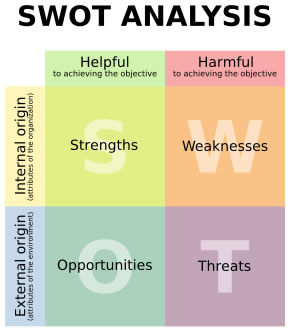SWOT analysis
SWOT Analysis is a strategic planning method used to evaluate the Strengths, Weaknesses, Opportunities, and Threats involved in a project or in a business venture. It involves specifying the objective of the business venture or project and identifying the internal and external factors that are favorable and unfavorable to achieving that objective.
SWOT stands for Strengths, Weaknesses, Opportunities and Threats.
From an organization point of view SWOT will show the following:
- Strengths: attributes of the organization that are helpful to achieving the objective.
- Weaknesses: attributes of the organization that are harmful to achieving the objective.
- Opportunities: external conditions that are helpful to achieving the objective.
- Threats: external conditions which could do damage to the business's performance.
SWOT analysis is used to find the answers to the following questions.
- How can we Use and Capitalize on each Strength?
- How can we Improve each Weakness?
- How can we Exploit and Benefit from each Opportunity?
- How can we Mitigate each Threat?
Aim
The aim of any SWOT analysis is to identify the key internal and external factors that are important to achieving the objective. These come from within the company's unique value chain. SWOT analysis groups key pieces of information into two main categories:
Internal factors – The strengths and weaknesses internal to the organization. These may include factors such as the 4P's; as well as personnel, finance, manufacturing capabilities, and so on.
External factors – The opportunities and threats presented by the external environment to the organization. The external factors may include macroeconomic matters, technological change, legislation, and socio-cultural changes, as well as changes in the marketplace or competitive position. The results are often presented in the form of a matrix.
Click here for more information
Watch a Video





